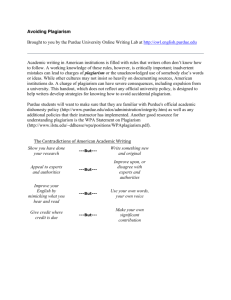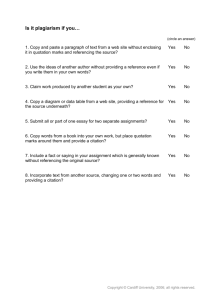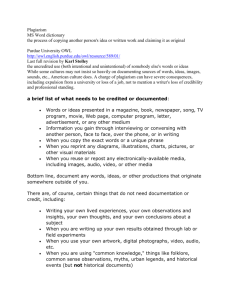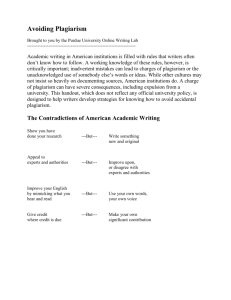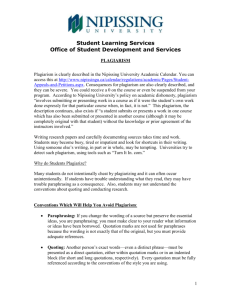Avoiding Plagiarism
advertisement
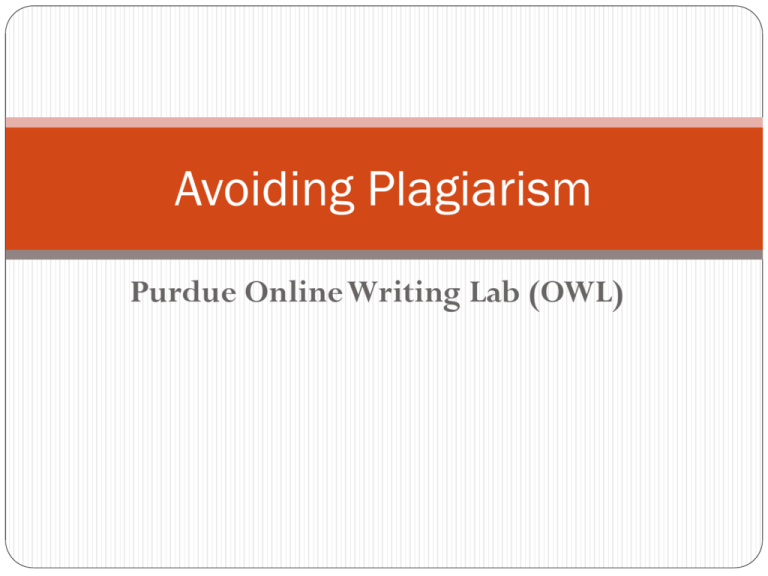
Avoiding Plagiarism Purdue Online Writing Lab (OWL) Intellectual Challenges in American Academic Writing There are some intellectual challenges that all students are faced with when writing. Sometimes these challenges can almost seem like contradictions, particularly when addressing them within a single paper. (Overview and Contradictions) American teachers often instruct students to Develop a topic based on what has already been said and written BUT Write something new and original Rely on experts' and authorities' opinions BUT Improve upon and/or disagree with those same opinions Give credit to previous researchers BUT Make your own significant contribution (Overview and Contradictions) Obvious Examples of Plagiarism There are some actions that can almost unquestionably be labeled plagiarism. Some of these include buying, stealing, or borrowing a paper (including, of course, copying an entire paper or article from the Web); hiring someone to write your paper for you; and copying large sections of text from a source without quotation marks or proper citation. (Is It Plagiarism Yet?) Gray Areas But then there are actions that are usually in more of a gray area. Some of these include using the words of a source too closely when paraphrasing (where quotation marks should have been used) or building on someone's ideas without citing their spoken or written work. Sometimes teachers suspecting students of plagiarism will consider the students' intent, and whether it appeared the student was deliberately trying to make ideas of others appear to be his or her own. (Is It Plagiarism Yet?) Give Credit Where Credit is Due The key to avoiding plagiarism is to make sure you give credit where it is due. This may be credit for something somebody said, wrote, emailed, drew, or implied. (Is It Plagiarism Yet?) What Needs to Be Credited or Documented Words or ideas presented in a magazine, book, newspaper, song, TV program, movie, Web page, computer program, letter, advertisement, or any other medium Information gained through interviewing or conversing with another person, face to face, over the phone, or in writing Copying of exact words or of a unique phrase Reprinting of any diagrams, illustrations, charts, pictures, or other visual materials Reusing or reposting of any electronically-available media, including images, audio, video, or other media (Is It Plagiarism Yet?) Things That Do Not Need Credit or Documentation Writing your own lived experiences, your own observations and insights, your own thoughts, and your own conclusions about a subject Writing up your own results obtained through lab or field experiments Using your own artwork, digital photographs, video, audio, etc. Using "common knowledge," such as folklore, common sense observations, myths, urban legends, and historical events (but not historical documents) Using generally-accepted facts, e.g., pollution is bad for the environment; including facts that are accepted within particular discourse communities, e.g., in the field of composition studies, "writing is a process" is a generally-accepted fact. (Is It Plagiarism Yet?) Deciding If Something Is “Common Knowledge” Generally speaking, you can regard something as common knowledge if you find the same information undocumented in at least five credible sources. Additionally, it might be common knowledge if you think the information you're presenting is something your readers will already know, or something that a person could easily find in general reference sources. However, when in doubt, cite; if the citation turns out to be unnecessary, your teacher or editor will tell you. (Is It Plagiarism Yet?) Writing Paraphrases and Summaries Use a statement that credits the source somewhere in the paraphrase or summary, e.g., According to Jonathan Kozol, .... If you're having trouble summarizing, try writing your paraphrase or summary of a text without looking at the original, relying only on your memory and notes Check your paraphrase or summary against the original text; correct any errors in content accuracy, and be sure to use quotation marks to set off any exact phrases from the original text Check your paraphrase or summary against sentence and paragraph structure, as copying those is also considered plagiarism. Put quotation marks around any unique words or phrases that you cannot or do not want to change, e.g., "savage inequalities" exist throughout our educational system (Kozol). (Safe Practices) Writing Direct Quotations Keep the source author's name in the same sentence as the quotation Mark the quotation with quotation marks, or set it off from your text in its own block, per the style guide your paper follows Quote no more material than is necessary; if a short phrase from a source will suffice, don't quote an entire paragraph (Safe Practices) Writing Direct Quotations (cont’d) To shorten quotations by removing extra information, use ellipsis points (...) to indicate omitted text, keeping in mind that three ellipsis points indicate an in-sentence ellipsis, and four points indicate an ellipsis between two sentences (Safe Practices) Writing Direct Quotations (cont’d) To give context to a quotation, or otherwise add wording to it, place added words in brackets, [ ]; be careful not to editorialize or make any additions that skew the original meaning of the quote—do that in your main text, e.g., ACCEPTABLE: Kozol claims there are "savage inequalities" in our educational system, which is obvious. UNACCEPTABLE: Kozol claims there are "[obvious] savage inequalities" in our educational system. (Safe Practices ) Writing Direct Quotations (cont’d) Use quotations that will have the most rhetorical and/or argumentative impact in your paper; too many direct quotations from sources may weaken your credibility—implying you have nothing to say yourself—and will certainly interfere with your style. (Safe Practices) Writing About Another’s Ideas Note the name of the idea's originator in the sentence or throughout a paragraph about the idea Use parenthetical citations, footnotes, or endnotes to refer readers to additional sources about the idea, as necessary Be sure to use quotation marks around key phrases or words that the idea's originator used to describe the idea (Safe Practices) Check Out the OWL Website! There is additional helpful information about research writing at the Purdue OWL website. This information includes exercises on identifying what needs to be cited and how to cite it, using a variety of styles including MLA and APA, among others. The website also offers flash movies and podcasts on many aspects of academic writing—it’s great! http://owl.english.purdue.edu/owl/ Works Cited Stolley, Karl and Allen Brizee. “Avoiding Plagiarism.” Purdue Online Writing Lab OWL. Purdue University. 14 Jan. 2011. Web. 21 March 2011.

